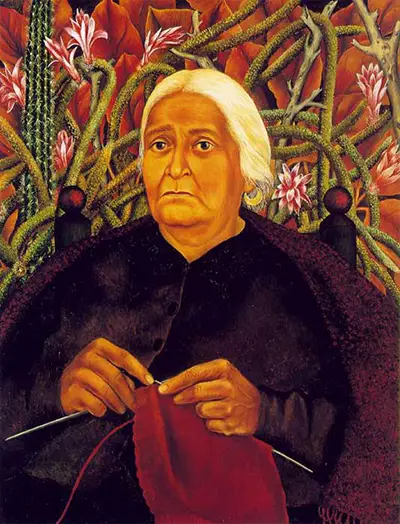Kahlo presents one of Mexico's grandmothers in a rather stoic and robust mannerism that appraises the world around her. The background is dense with foliage, creating a sense of encroachment; only Dona's strength can withstand. Khalo manages to portray her resolute personality by creating an image of a busy woman who is knitting. She uses different varieties of red throughout the composition and balances them out with the dark hues on Rosita's clothes. She also creates a subtle contrast between the subject's wary appearance with the bright, riotous cactus behind her.
Like other contemporary Mexican artists, Mexinacidad style greatly influenced Frida's work. This style was adopted during the aftermath of the revolution in a bid to resist the mindset of a culturally inferior group in Mexico. Before this revolution, the elite belittled the Mexican culture that was made up of a mixture of European and natives. This group regarded Europe as the pioneers of civilisation that natives should imitate. As a result, Khalo’s artistic skill was to portray the Mexican people as superior to the Europeans.
In the 1940s, the Mexican government commissioned Kahlo to paint portraits of important Mexican women and among them was Dona Rosita, Eduardo’s mother. Proponents argue that Kahlo created this painting out of her deep longing for her mother’s embrace, but it was related mainly to the commission to draw 30 portraits of Eduardo's family. Sadly Kahlo was not able to finish the project given the chronic health problems she had. She was only able to resume this commission in 1944 after going through a few surgeries. Eduardo also commissioned her to paint several portraits of his family members, and the Portrait of Dona Rosita Morillo emerged the best.
Portrait of Eduardo Morillo Safa
Following Eduardo’s commission, Kahlo painted Eduardo’s daughter, Mariana. The painting portrayed the girl’s calmness and innocence thanks to the spectrum of warm colours used. A background of leaf patterns and dense leaves serve to protect the little girl. Kahlo developed a pretty healthy relationship with Mariana as she used to play and take care of her while creating this portrait. They remained great friends until Khalo passed on in 1954.

